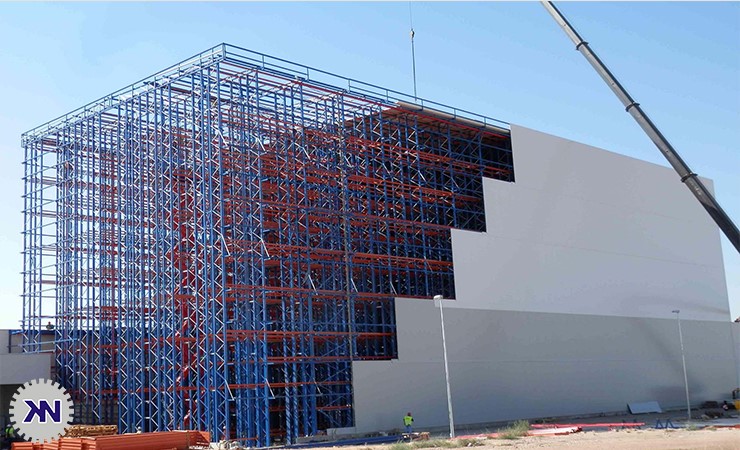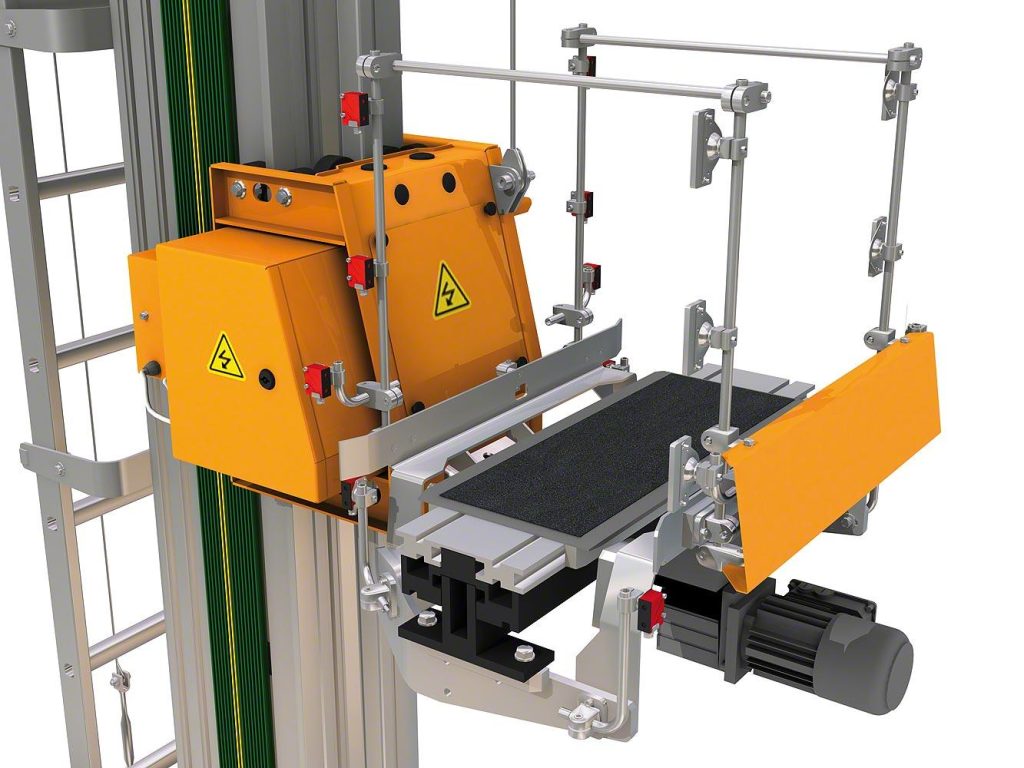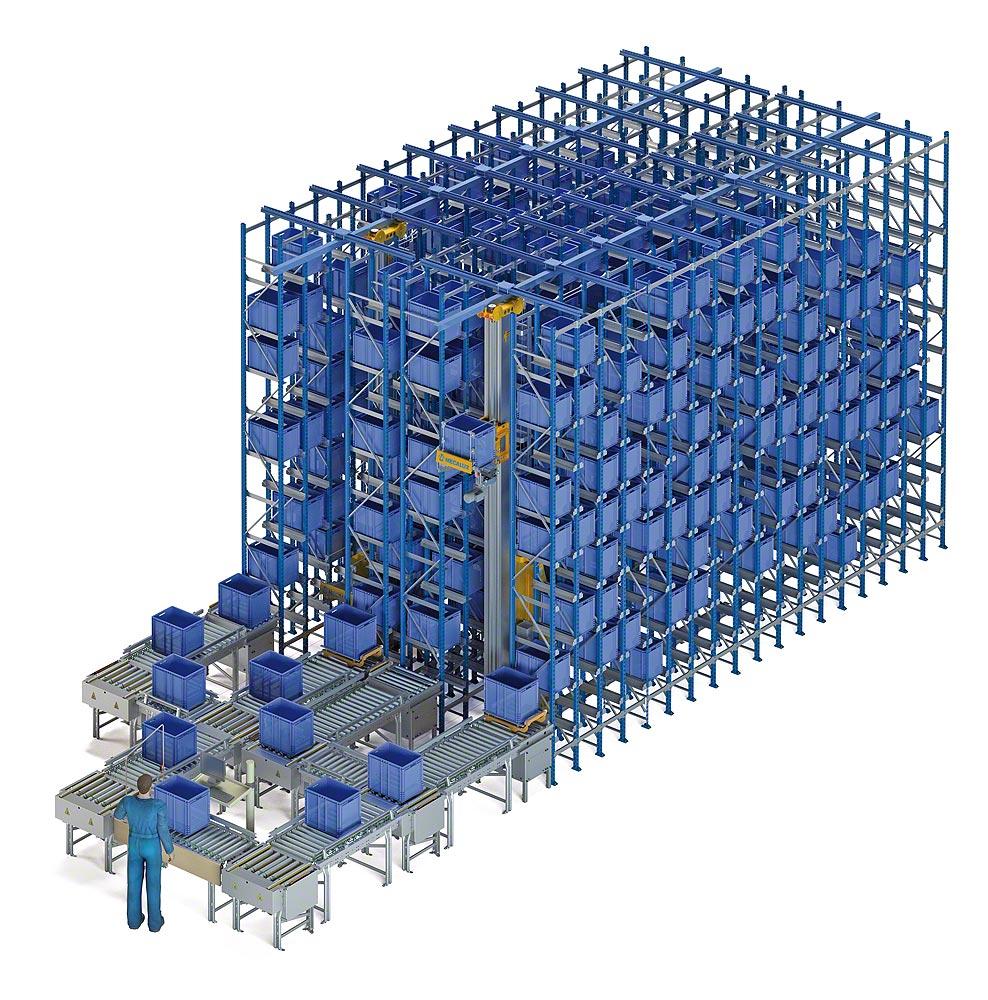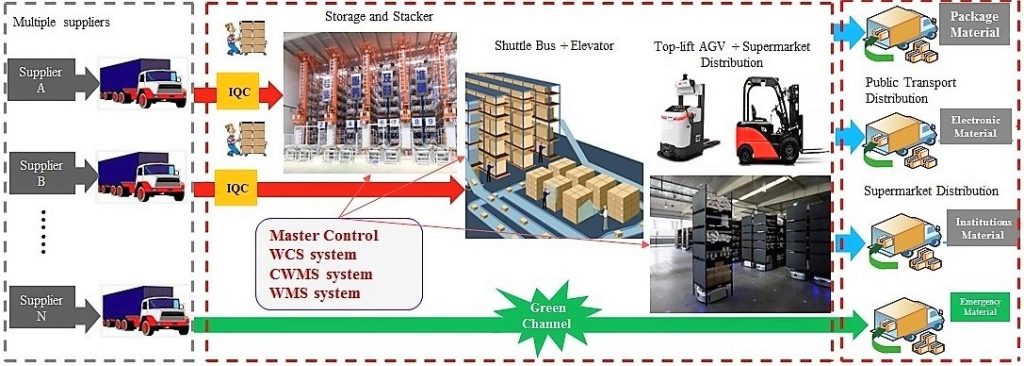AS/RS (تکنولوژی ذخیره/ بازیابی اتوماتیک)

سيستم هاي ذخيره-بازيابي اتوماتيك (Automated Storage & Retrieval System=AS/RS) به نوعي انبار اتلاق مي گردد كه در آن عمليات دريافت كالا، چيدمان كالا در قفسه ها و برداشت كالا از قفسه ها، براساس نيازمندي به كالائي مشخص و ارسال آن كالا به منظور خروج از انبار، بصورت خودكار، هوشمند و بدون دخالت مستقيم انسان صورت پذيرد و حضور حداقلي انسان، تنها به عنوان اپراتور و كنترلر سيستم خواهد بود . يكي از مهم ترين ويـژگي هاي انـبارهاي اتوماتيك، امكان افزايش ارتفاع چيـنش ماژول ها(مانند انواع پالت يا سبد حاوي كالا يا فاقد كالا) كالا بوده كه سبب كاهش چشمگير سطح زيربناي انبار، بدليل استفاده از قفسه های مرتفع می باشد، که اين مهم نیز از طريق بكارگيري ماشين ذخيره- بازيابي (Stacker Crain) كه مسئوليت حمل كالا در راهروهاي مابين قفسه ها را بر عهده دارد، با دقت ، سرعت و كيفيت مطلوب ، تحقق می یابد. بديهي است محدود شدن عرض راهروهاي تردد ماشين ذخيره- بازيابي، تا حد عرض پالت ها، از ديگر دستاوردهاي مهم اين تكنولوژي، در راستاي كمينه سازي سطح زيربناي انبار مي باشد. از ديگر نكات حائز اهميت در انبارهاي اتوماتيك، يكپارچگي عمليات جاري در انبار، توسط “سيستم نرم افزاري مديريت انبار” است كه از لحظه دريافت كالا برروي نقاله هاي ورودي انبار تا تحويل كالا بر روي نقاله خروجي، ضمن رديابي دقيق و شناسائي ويژه هر كالا، مديريت عمليات دريافت، رديابي، جايابي و چيدمان بهينه، برداشت و عودت، جهت ارسال را بطور كامل بر عهده دارد. نهايتاً سرعت بالاي عمليات در اين نوع انبار، ضمن حفظ كيفيت كالا، در حد بالائي موجب افزايش ظرفيت خدمت دهي (ارسال و دريافت) و سهولت بارگذاري ظرفيت هاي آزاد انبار مي شود. اصولاً در انبارهاي اتوماتيك، بكارگيري تركيبي از ماشين الات حمل و سيستم هاي نرم افزاري مدیریت انبار (WMS)، امكان استفاده بهينه از کلیه تجهيزات را فراهم مي سازد. اين نرم افزارها ضمن ساماندهي گردش عمليات انبار، شرائط مسيريابي بهينه ﺑﺎ استفاده از الگوریتم های بهينه يابي ریاضی، در راستاي تعيين ﮐﻮﺗﺎﻫﺘﺮﯾﻦ مسیر حمل ﺑﺎر را فراهم ﻣﯽﮐﻨﺪ كه این مهم، سبب كاهش هزينه هاي انرژي، كاهش اﺳﺘﻬﻼك ﻣﺎشين آلات، افزايش سرعت خدمات و نهايتاً كمينه سازي تعداد تجهيزات حمل مي گردد.

خلاصه مهمترين ويـژگي هاي تکنولوژی AS/RS بشرح ذیل می باشد:
⦁ افزايش ظرفيت انبار ناشی از بکارگیری ارتفاع در مقابل كاهش مساحت انبار.

⦁ كاهش مساحت زمين مورد نياز، تا حدود 1/3 (با توجه به كمبود گزينه هاي زمين، در متراژهای بالا و با موقعيت مناسب).
⦁ افزايش ظرفیت خدمت دهي در مقابل كاهش نيروي انساني.
⦁ تخصيص مكان هاي جايگذاري بصورت اتوماتيك و جايابي بدون اشتباه.
⦁ بهبود گردش فرايندهای بارگيري/ ارسال و افزايش سرعت خدمت دهي.
⦁ صرفه جويي در مصرف انرژي، بدليل پيمايش كوتاه ترين مسيرها.
⦁ كاهش كسري موجودی انبار، ناشي از سرقت كالا، بدليل عدم نیاز به تردد پرسنل در ناحيه قفسه بندي شده.
⦁ امكان ايجاد شبكه اعلام و اطفاء حريق، بر روي تك تك سلول هاي قفسه ها، در راستاي ارتقاء امنيت سرمايه های انبار.
⦁ امكان بكارگيري فضاي كليه سلول هاي قفسه هاي انـبار، به دليل استفاده از آدرس متغير (كد مكان ديناميك) براي كليه كالاها.
⦁ امکان ایجاد شبکه ای از تکنولوژی ها و تجهیزات مرتبط و متعامل با یکدیگر در راستای تسهیل در عملیات انبار.

⦁ اطلاع از موجودي لحظه اي انبار و سهولت انبارگرداني در هر مقطع زماني.
⦁ امكان شناسائي يا اعلام كالاهاي تاريخ نزديك و اولويت دهي هوشمند براي ارسال اقلامي كه دوره انقضاء نزديك دارند.
⦁ قابليت برنامه ريزي همزمان ارسال انواع كالاها، براساس روش هاي Fifo ، Lifo و ….
⦁ عدم نياز به احداث سوله و صرفه جوئي در هزينه هاي مربوطه در ترکیب با تكنولوژي قفسه هاي خودسوله و برپائي فضاي محصور، از طريق نصب پوشش (ساندويچ پانل) در پيرامون سازه مذکور.

⦁ افزايش ظرفيت انبار، از طريق كاهش تعداد راهروهاي ميان قفسه اي، با بكارگيري ماشين ذخيره-بازيابي داراي قابليت حمل همزمان يا جاگذاري بيش از يك پالت يا سبد كالا در عمق.


⦁ عدم نياز به پرسنل جابجائي كالا، مانند راننده ليفتراك، كنترلر كالا و غیره.
⦁ کاهش چشمگیر ضايعات ناشي از خطاهاي انساني، بعلت حمل تمام اتوماتیک کالا، در کلیه قسمت های انبار.
⦁ امكان بازآرائی (Defragment) اتوماتيك چيدمان كالاهاي موجود در قفسه ها، طي زمان هاي بيكاري سيستم.
⦁ كاهش مصرف انرژي، بدليل عدم نياز به سرمايش يا گرمايش محيط
⦁ حذف يا كاهش تردد تجهيزات حمل وابسته به اپراتور (راننده) در انبار و داخل سالن ها به واسطه بکارگیری شبکه ای متشکل از انواع نقاله ها.


⦁ جلوگيري از كاربري غلط تجهيزات حمل و مخاطرات ناشی از آن.
⦁ امكان افزايش چشمگیر ارتـفاع چينش كالا، كه سبب كاهش سطح زيربناي انبار می گردد.

⦁ در انبارهاي اتوماتيك ، بكارگيري تجهيزات حمل، بدليل بهره گيري از الگوريتم هاي بهينه يابي رياضي، در حداقل ممكن بوده و اين موضوع، جدا از كاهش هزينه، موجب كاهش تعداد ماشينهاي مورد نياز، مي شود .
⦁ تامین يكپارچگي عمليات جاري در انبار توسط سيستم نرم افزاري مديريت انبار(WMS) كه از لحظه دريافت كالا، بر روي نقاله هاي ورودي انبار، تا تحويل كالا بر روي نقاله هاي خروجي، ضمن رديابي دقيق و شناسائي ويژه هر كالا، مديريت عمليات ذیل را برعهده دارد
⦁ امكان افـزايش ظرفيت عملیات از طـريق تفکیک و افـزايش طبقات ناحيه ارسال و دريافت كالا

⦁ کمینه شدن عرض راهروهاي تردد ماشين ذخيره – بازيابي، تا حد عرض پالت ها
⦁ امكان ايجاد ناحيه ورود و خروج كالا، از يك يا دو سمت انبار اتوماتيك


⦁ امكان مشاركت عملياتي با ساير تكنولوژي هاي انبار، از جمله انواع سیستم های قفسه بندي خودجريان و يا ساير انواع تجهيزات حمل مانند ریچتراک و VNA



⦁ هوشمندی تکنولوژی ذخیره-بازیابی اتوماتیک، تحت سیستم WMS و در قالب بهينه سازي عملكرد سيستم، توسط الگوریتم های بهینه یابی ریاضی فوق ابتکاری
مهم ترين اجـزاء انبارهاي ذخيره-بازيابي اتوماتيك، مطابق نمودار ذيل مي باشند :

1- ماشين ذخيره- بازيابي :
ماشين ذخيره-بازيابي به عنوان مهم ترین بخش تکنولوژی AS/RS ، عمل ذخيره كالا در قفسه و بازيابي كالاي ذخيره شده، جهت ارسال را بطور اتوماتيك انجام مي دهد و در حقيقت، كالا را از سلول هاي قفسه برداشته و يا برعكس، از بخش ورودي انبار، ماژولی را دريافت و در سلول قفسه مورد نظر قرار مي دهد و در این عمل از شاخك هائي بهره می گیرد که كالاي مورد نظر را دریافت کرده و به داخل یا خارج کالسکه حمل کالا، هدایت می کند. ماشین ذخیره- بازیابی، دارای دو نوع حرکت اصلی در راستاي افقي و عمودي است که شامل حرکت خطی مربوط به جابجائی در طول راهروها و یا حركت خطي ديگري به منظور بيرون كشيدن كالا يا جايگذاري كالا در سلول قفسه می باشد. در مجموع، ماشين ذخيره- بازيابي، به كمك آميخته اي از سخت افزارها و نرم افزارها، امكان جابجائي و انبارش انواع ماژول ها را در ميان گستره اي از تكنولوژي هاي قفسه بندي انبار، با سرعت و كيفيت مطلوب فراهم مي سازد.

مهم ترین بخش های ماشین ذخیره-بازیابی بشرح ذیل است:
1-1 – تكيه گاه تحتاني (Lower Support) :تكيه گاه تحتاني مسئوليت جابجائي ماشين ذخيره-بازيابي، بر روي ريل كف (نصب شده روي كف سالن) را برعهده دارد، شامل تير، چرخ ها و محل قرارگيري (اتصال) ستون ها بر تکیه گاه مي باشد ضمناً برق اصلي ماشين ذخيره-بازيابي، از طريق ريل تغذيه (Power feed Rail) به موتوري كه بر روي تكيه گاه تحتاني قرار دارد، تامين مي شود.

2-1 – تكيه گاه فوقاني (Upper Support) مسئوليت تكيه گاه فوقاني، حفظ ايستائي و نگهداري سازه ماشين ذخيره-بازيابي، به موازات قفسه ها و جلوگيري از خروج آن از راستاي طراحي شده مي باشد، كه اين عمل توسط چرخ هايي كه بر روي طرفین تكيه گاه فوقاني تعبيه شده، صورت می پذیرد.

عموماً به منظور تامين مسير حركت تكيه گاه فوقاني، از ريل داراي مقطع I (آی) بال پهن، كه توسط مهار، به زير سازه سقف متصل گرديده، استفاده مي شود. بديهي است برای تامين ايستائي قائم در ماشين ذخيره-بازيابي، بايستي ريل فوقاني (متصل به سازه سقف) و ريل تحتاني (نصب شده بر روي زمين) بطور كاملا موازي (با حداقل تلرانس انحراف)، نصب گردند.

3-1 – كالسكه (Carriage Equipment) عملیات بارگذاري و باربرداري در داخل قفسه ها، توسط كالسكه مجهز به انواع شاخک انجام مي شود و در واقع کالسکه ماشین ذخیره-بازیابی، ابزار اصلی حمل ماژول کالا است که براساس نوع ماژول (از لحاظ ابعاد و وزن) و همچنین قابلیت حمل همزمان یک یا چند ماژول، دارای انواع مختلفی است، همچنین گستره ماژول های قابل حمل توسط کالسکه می تواند از انواع ماژول های کوچک و سبک مانند کارتن و سبد پلاستیکی تا پالت های سنگین بیش از 3000 Kg را شامل شود. لازم بذکر است که ماشین های ذخیره-بازیابی براساس وزن ماژول قابل حمل و ابعاد آن به دو گروه اصلی mini-load برای حمل کالاهای سبک، مانند سبد پلاستیکی یا کارتن و unit-load برای حمل کالاهای سنگین مانند پالت یا جامبوبگ تقسیم می شوند.


عملیات بارگذاري و باربرداري در داخل قفسه ها، توسط كالسكه مجهز به انواع شاخک انجام مي شود و درواقع کالسکه ماشین ذخیره-بازیابی، ابزار اصلی حمل ماژول کالا است که براساس نوع ماژول (از لحاظ ابعاد و وزن) و همچنین قابلیت حمل همزمان یک یا چند ماژول، دارای انواع مختلفی است، همچنین گستره ماژول های قابل حمل توسط کالسکه می تواند از انواع ماژول های کوچک و سبک مانند کارتن و سبد پلاستیکی تا پالت های سنگین بیش از 3000 Kg را شامل شود.


لازم بذکر است که ماشین های ذخیره-بازیابی براساس وزن ماژول قابل حمل و ابعاد آن به دو گروه اصلی mini-load برای حمل کالاهای سبک، مانند سبد پلاستیکی یا کارتن و unit-load برای حمل کالاهای سنگین مانند پالت یا جامبوبگ تقسیم می شوند.


همچنین براساس عمق انباشت کالا در قفسه، تجهیز ذخیره-بازیابی می تواند از یک تا سه ماژول کالا را ضمن حذف راهروهای مابین قفسه های مذکور، بارگذاری یا بار برداری انجام دهد. لازم بذکر است که افزایش عمق انباشت، راهکاری هوشمندانه برای افزایش سطح تحت پوشش قفسه و درنتیجه ارتقاء ظرفیت انبارش کالا تلقی می گردد.

البته درصورت نیاز به بارگذاری و باربرداری در عمق بیش از سه ماژول، امکان ترکیب تکنولوژی AS/RS با انواع Shuttle تک بعدی فراهم نیز می باشد



2- سیستم مدیریت انبار (WMS)

بطوركلي عمليات مرتبط با انبارش کالا در دو حوزه اصلی مطرح مي باشند که عبارت است از، دريافت مواد اوليه يا كالاي نيمه ساخته از بيرون انبار، بمنظور نگهداري و تحويل بموقع به فرايند بعدي (فاز دريافت و انبارش) و شناسائي، گزينش و انتقال كالا، به منظور انتقال به خارج از انبار (فاز شناسائي و ارسال)، لذا باتوجه به گستردگي و تنوع عمليات مذكور، استقرار سيستمي يكپارچه، تحت عنوان سيستم مديريت انبار(WMS)، با قابليت مديريت دريافت، شناسائي ويژه، چينش و انبارش، گزينش و ارسال، ضروری بنظر مي رسد و بدين منظور، تكنولوژي هاي نويني از جمله تجهيزات شناسائي خودكار مانند اسكنر باركد، دستگاه هاي ثبت و جمع آوري اطلاعات توسط توسعه داده شده كه مديريت پوياي عمليات انبار را در بستر شبكه با بالاترين دقت و كيفيت، ميسر می سازد.
سيستم مديريت انبار، يكي از مهم ترين و تاثيرگذارترين بخش هاي لجستیک داخلی است كه شرائط عملكرد هماهنگ اجزاء درگير در فرايند مذكور را فراهم مي سازد. اين سيستم، كليه مراحل دريافت كالا، چينش كالا در مكان هاي انبارش، شناسائي و رديابي كالا، برداشت و جمع آوري كالا و نهايتاً حمل كالا از انبار به ناحيه تحويل را برعهده دارد.

اصولاً نرم افزار مديريت انبار، وظيفه مديريت موجودي هاي انبار، از لحظه ورود كالا به انبار تا خروج را برعهده دارد، كه اين اقدام، از طريق آدرس دهي به اقلام وارده به انبار، براساس معرفي سلول قفسه ها در نرم افزار مديريت انبار، پي گرفته مي شود. لذا كد مكان (location)، مبناي گسيل ماشين ذخيره-بازيابي به قفسه اي معين خواهد بود. اين ويژگي موجب مي گردد سلول ثابتي به يك كالاي معين اختصاص نيابد، بنابراين عملكرد نرم افزار مديريت انبار، براساس آدرس دهي ديناميك است كه تضمين كننده حداكثر بهره گيري از ظرفيت هاي انبار مي باشد.

3- تجهیزات جانبی
در انبارهای اتوماتیک گستره ای از تجهیزات برای تکمیل عملیات مورد استفاده قرار می گیرد که ذیلا به اختصار معرفی شده اند.
3-1 – نقاله ها
که در انواع مختلف، مسئولیت جابجائی اقلام انبار در مسیرهای مشخص را بر عهده دارند، موجب ایجاد جریانی ثابت و قابل مدیریت از کالای در حرکت می شوند . متداول ترين انواع نقاله های مورد استفاده در انبارهای اتوماتیک، عباتنداز :
⦁ نقاله چرخشي
⦁ نقاله كنترل پالت
⦁ نقاله بالابر
⦁ نقاله زنجيري
⦁ نقاله غلطكي
⦁ نقاله تغيير مسير
⦁ نقاله تغيير مسير منحني
⦁ نقاله مارپيچي

3-2 – روبات (Robots)
بمنظور افزايش سرعت عمليات انبار و جهت افزايش دقت در انجام فعاليتهاي سنگين، طولاني مدت یا پر تکرار، از انواع روبات ها بهره گرفته مي شود، بعنوان مثال در بسياري صنايع از روبات هاي چيدمان كالا بر روي پالت (Palletizer)يا برداشت كالا از روي پالت (Depalletizer)، استفاده مي گردد. در انبارهاي اتوماتيك نيز روبات هاي چينش كالا (Picking Robots)، براي عمليات چیدمان با حجم بالا و پيچيده بكار گرفته می شوند. اين روبات ها قادر هستند بصورت اتوماتيك، جابجائي يك عدد كالا (بعنوان مثال یک جعبه تكي) و يا جابجائي همزمان چند جعبه مستقر در يك لايه، برروي ماژول حمل را انجام دهند. از مهمترين مباني انتخاب نوع روبات، مي توان به تعداد سيكل هاي كاري در هر ساعت، پيچيدگي عمليات، ابعاد و وزن ماژول اشاره نمود. امروزه روبات ها داراي انواع بسيار متنوعي هستند ولي روبات هاي مورد استفاده در انبارهاي اتوماتيك عموماً به سه گروه اصلي قابل تفكيك مي باشند شامل:
⦁ روبات شبه انسان
⦁ جرثقيل دو محور
⦁ جرثقيل سه محور


3-3- سیستم دسته بندی (Sorter)
در انتهاي فرايند آماده سازی سفارش و بمنظور تفكيك و دسته بندي سفارشات آماده ارسال، سیستم دسته بندی (sorter) براساس نقاط مصرف يا نواحي توزيع و فروش بکار گرفته می شود. دراين سيستم، كليه اقلام مرتبط با يك سفارش، در انتهاي مسيري از نقاله هاي فرعي تجمع مي يابند تا از طريق ماشين هاي حمل، عمليات ارسال و توزيع سفارشات صورت پذیرد.



بديهي است ابعاد ماژول، وزن مـاژول و همچنين ظرفيت تفكيك مورد انتظار ، از مولفه هاي تاثيـرگذار در انتخاب ماشين تفكيك خواهد بود و بر این اساس انواع تکنیک های تفکیک کالا، مطابق نمونه های ذیل توسعه یافته اند.



4-3- واگن (RGV)
بدليل كاربرد گسترده سيستم هاي تفكيك سفارش، درصورتيكه تعـداد و تنـوع ماژول زياد باشد از شـبكه گسترده اي از خطـوط طويل و غيرهمسطح بهره گرفته مي شود كه گردش عميات اين شبكه نيز توسط نرم افزارهايWMS و WCS مديريت مي گردند. واگن ها وظيفه انتقال هوشمند پالت كالا، به منظور تحويل يا دريافت پالت از اجزائی مانند استاكر جهت انتقال به خطوط نقاله را برعهده دارد . در واقع واگن ها در يك انبار اتوماتيك، عمل برقراري بالانس ظرفيت و موجودي در جريان را انجام مي دهند بگونه اي كه در زمان نياز ، پالت كالا را به استاكر يا نقاله ها تحويل دهند . واگـن ها با مسيرهاي خطي يا حلقوي ساخته مي شوند و برحسب نياز، قابليت حمل يك يا چند پالت را دارا مي باشند (متوسط سرعت واگن در طراحي اين سيستم بين 150 الي 250 متر در دقيقه است)


